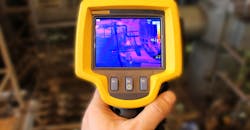Sensor Smarts: 4 Considerations for Post-COVID Workplaces
As economies worldwide begin recovering from COVID-19 shutdowns, companies that safely and responsibly reopen their physical spaces at scale can have a distinct competitive advantage over those that cannot do so.
Many businesses are considering the use of sensors to create smart, safe buildings. These devices range from thermographic cameras that check occupants for fevers to Bluetooth wristbands that warn wearers of people coming too close together.
Tempting as it may be to roll out such technology quickly and get back to business, deployment must be a well-orchestrated process to achieve the real benefits. If sensors are deployed incorrectly, the devices and the data they gather will fail to deliver the information businesses really need, risk violating privacy rules, and alienate employees and customers.
Here are four critical factors to consider to successfully roll out a sensor-based, smart workspace and derive maximum value:
1. Sensor technologies
The most widely deployed sensors in enabling smart, safe buildings are wearable cameras around the wrist or on a lanyard.
Thermographic cameras can detect elevated skin or core body temperatures and monitor physical distancing and occupancy density without capturing facial features.
Because these cameras have only recently been used to detect body temperature, the algorithms that analyze their output must properly account for false negatives and false positives. Businesses using these cameras should plan for backup processes to verify that temperature readings are correct. The same calibration and review methods also apply to optical cameras, which are now being used to monitor distancing and density levels.
For a rapid rollout, businesses must take into account the appropriate wearable devices – from Bluetooth to ultra-wideband/LTE-based devices – for specific environments and ensure their fitment and availability. Surging demand and COVID-19-related supply chain disruptions have led to shortages of both wearable devices and optical cameras. Standardizing on a single model of each device for each facility in each region and integrating them with a service provider can ease deployment and data gathering without waiting for suppliers to provide the necessary volume for enterprise-wide rollouts. This can be done on a monthly subscription basis, costing $20-$25 per employee per month for a manufacturing floor, for example, which outweighs the cost of not opening a business at all.
2. Multiple stakeholders
Companies must customize smart space strategies for various stakeholders. This includes office factory/warehouse workers, contractors, temporary staff, and customers. Some industries have specific privacy requirements as well.
With office workers in commercial spaces, employers have more flexibility to use self-declared health status, wellness surveys, and mobile apps on employee phones to enable contact tracing.
Factory and warehouse workers might not have access to mobile phones in the workplace and may require LoRaWAN/UWB/LTE-based wearables that are less susceptible to interferences than Bluetooth devices.
Thermographic and optical camera based solutions can be effective for monitoring physical distancing and fever detection in public environments across several industries. Restaurants, office buildings, manufacturing plants, and casinos are actively evaluating, piloting, and rolling out these devices.
3. Standardization, data integration, and workflow
With so many choices in sensors as well as availability constraints, most large companies will deploy wearables and sensors from multiple manufacturers. However, all of the data they produce must be integrated, processed, analyzed, and acted on consistently.
For example, regardless of the thermographic camera manufacturer, an enterprise must receive, act on, and interpret the temperature data in a workflow that identifies the potentially infected employees and revoke their entry into facilities by disabling their access cards until they are tested. Access to facilities can be reinstated upon proof of fitness. Organizations should have a data integration layer in place to ensure consistent, timely gathering, data cleansing and analysis, and consistent workflows.
4. Designing for privacy
In many jurisdictions, regulations forbid the capture of personally identifiable data, such as information that might be useful for contact tracking or identifying employees who fail to maintain social distancing. Although thermographic cameras do not capture facial features, knowing the privacy regulations in each region in advance is critical before designing the overall solution. Businesses also need to take into account human factors such as training, consent, and privacy notifications to ensure regulatory compliance, as well as the privacy rights of staff, customers, and partners.
Incorporating these insights into a strategic workspace plan can help businesses reduce risk and meet safety and compliance regulations. By implementing a flexible, scalable process to build smart-sensor-based, safe workspaces, businesses can effectively reopen while respecting privacy concerns and maximizing employee efficiency and public health.
Randal Kenworthy is vice president of IoT at Cognizant.
